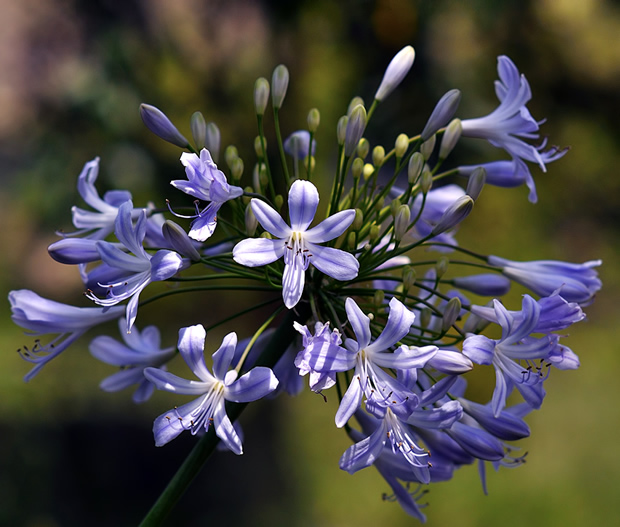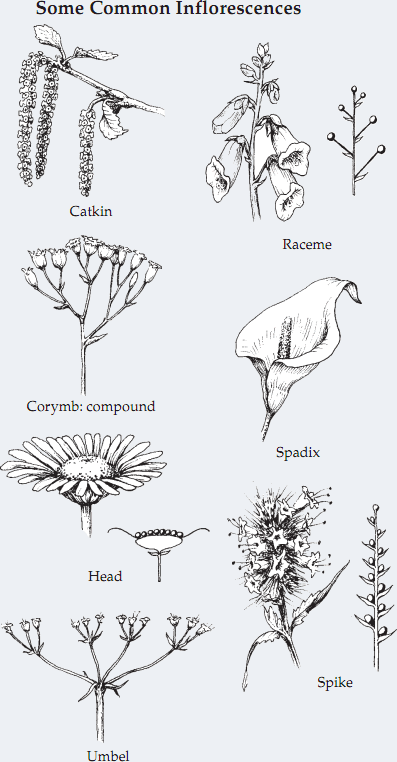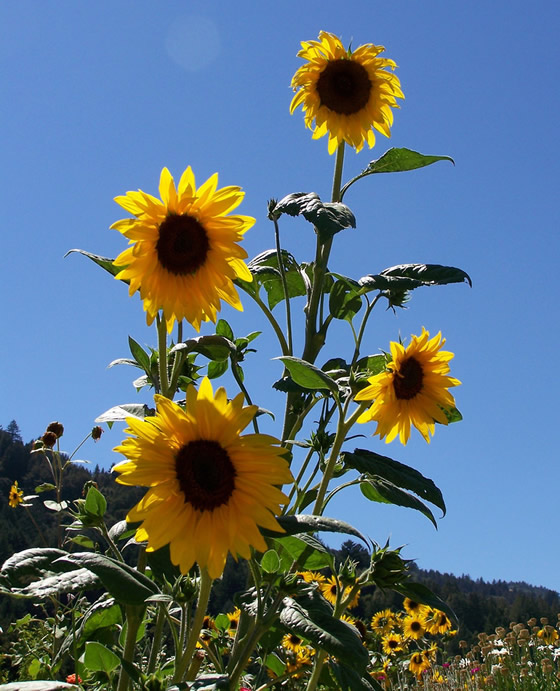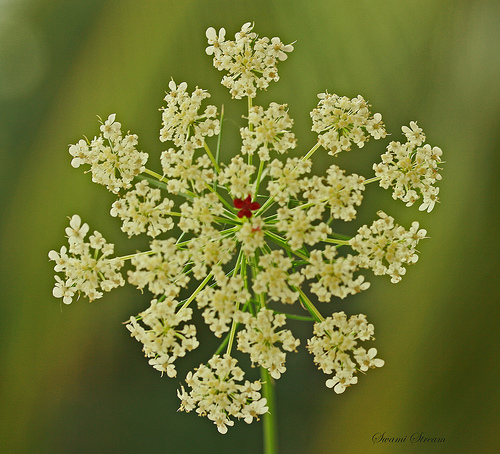 |
| Inflorescence |
The term "inflorescence" refers to the arrangement of flowers on a floral axis. Most schemes that define inflorescence types separate solitary flowers from flower clusters and stipulate that an inflorescence is a cluster of two or more flowers.
It is not always easy to distinguish between solitary flowers and an inflorescence. An examination of the evolutionary development of the flower and the inflorescence provides some insight into the problem. It generally is accepted that the flower arose as a modified stem tip that bore male and female reproductive structures at its apex.
These reproductive structures became the pistils and stamen of the flower. Leaves that immediately subtended the reproductive structures became the sterile parts of the flower (petals and sepals) and are typically more leaflike as distance from the apex increases.
  |
If leaves subtending the flower are much smaller or distinctly different from regular leaves, they are referred to as bracts. If a second, considerably smaller set is present, its component parts are termed bracteoles. The determination of whether subtending leaflike structures are leaves or bracts may establish a flower as solitary or as part of an inflorescence.
Sometimes woody branches that support flowers are modified. They may grow much more slowly than branches that support only vegetative structures. The latter pattern is observed in many fruit tree species, such as apples and pears, where the fruit is supported by short, modified branches called spurs. Clusters of flowers issuing from such spurs may resemble inflorescence types, although the flowers are solitary.
 |
| catkin inflorescence |
Flowers may be complete, possessing all four sets of floral appendages, or they may be reduced to as little as one set of reproductive structures (stamen or pistils). If clusters of many reduced flowers are borne on very short stems, the resulting aggregation may superficially resemble a single flower.
This type of inflorescence is associated with daisies and asters (Asteraceae) and is often mistaken for a single flower by those unfamiliar with flower and inflorescence structure. In spite of these confusing elements, most common inflorescence patterns can easily be recognized.
Parts of an Inflorescence
The following terms, some of which already have been introduced, are features or structures that are used to classify inflorescences. An axillary bud occurs in the angles between a stem and a leaf petiole. Abract is a small or modified leaf immediately beneath a flower or inflorescence. Abracteole is a bract that is much smaller in size.
An involucre is a series of bracts or bracteoles subtending a flower or inflorescence. A pedicel is a stalk supporting a single flower of an inflorescence. Apeduncle is a stalk of a solitary flower or of an inflorescence. A rachis is the main branch or axis within a complex inflorescence.
Inflorescence Types
Parameters used to classify basic inflorescence types include
- number and position of flowers
- sequence of flower development, and
- the nature of inflorescence branching.
 |
| Inflorescence types |
Because the inflorescence type of a given species may result from evolutionary reduction, classification schemes are typically artificial and do not reflect evolutionary significance. The form of an inflorescence, however, is determined largely by two patterns of development.
If the growing tip of the stem (apical meristem) continues to grow and produce new flowers as it elongates, the inflorescence is said to be indeterminate. Araceme (defined below) is a typical indeterminate inflorescence. If the apical meristem quickly matures into a flower, it can no longer grow in length, and the inflorescence exhibits a limited growth pattern.
This type of inflorescence is said to be determinate and is best represented by a cyme (defined below). The following descriptions of inflorescence types represent most of the basic types. Any vascular plant taxonomy text will provide a more comprehensive list.
Indeterminate Inflorescences
A catkin (also known as an ament) is a spikelike inflorescence. Dissection may reveal the presence of minute, and possibly branched, pedicels. The flowers are typically unisexual and are hidden by bracts. This inflorescence is typical of trees such as oaks, hickories, and birches.
 |
| Head inflorescence |
A corymb is a flat-or rounded-top inflorescence. The pedicels of flowers are attached along the length of the peduncle. Corymbs may be simple or compound. Examples include hydrangea and hawthorn.
A head, or capitulum, is a tight cluster of sessile flowers (flowers with no pedicel) borne on a flattened or short stemtip (receptacle). Heads are a diagnostic feature of the sunflower family (Asteraceae), examples of which are daisies, chrysanthemums, and sunflowers.
A panicle has a branched floral axis (rachis), which may re-branch prior to bearing flower pedicels (described some times as a compound raceme).
   |
A raceme has pedicellate flowers borne on an elongate rachis. It is often confused with a spike when the pedicels are small and inconspicuous. Examples include foxglove and lupine.
A spike has sessile flowers borne on a single rachis. Examples are ladies’ tresses (a type of orchid) and plantain. A spikelet is a small spike. The flowers are inconspicuous and often hidden by a series of modified bracts. This is the basic inflorescence unit of grasses and sedges.
A spadix is a spike with flowers embedded in a fleshy rachis. Typically, the spadix is subtended and surrounded by a large modified bract termed a spathe. The spadix is characteristic of the arum family (Araceae), examples of which are jack-in-the-pulpit and elephant ear.
Determinate Inflorescences
An umbel can be determinate or indeterminate, with a flat or rounded top. The pedicels of flowers are attached to a common point on the peduncle.
Umbels may be simple or compound. Compound umbels are the typical inflorescence of most members of the carrot family (Apiaceae). Examples include onion, carrot, and dill.
A cyme is a branching inflorescence with individual flowers at the end of each branch. A simple cyme is determinate, with a grouping of three flowers on a peduncle. The central flower matures first. Examples include champions and some of the anemones. A compound cyme is composed of two or more cymes together. Examples include chickweed and phacelia.
